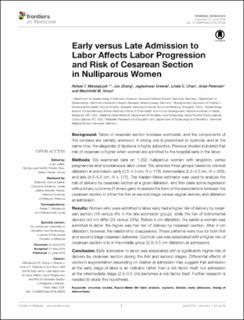Please use this identifier to cite or link to this item:
https://doi.org/10.21256/zhaw-4284| Publication type: | Article in scientific journal |
| Type of review: | Peer review (publication) |
| Title: | Early versus late admission to labor affects labor progression and risk of cesarean section in nulliparous women |
| Authors: | Mikolajczyk, Rafael T. Zhang, Jun Grewal, Jagteshwar Chan, Linda C. Petersen, Antje Gross, Mechthild Maria |
| DOI: | 10.21256/zhaw-4284 10.3389/fmed.2016.00026 |
| Published in: | Frontiers in Medicine |
| Volume(Issue): | 3 |
| Issue: | 26 |
| Issue Date: | 2016 |
| Publisher / Ed. Institution: | Frontiers Research Foundation |
| ISSN: | 2296-858X |
| Language: | English |
| Subjects: | Kaplan-Meier life table analysis; Cesarean section; Dilation; Early admission; Oxytocin; Timing of interventions |
| Subject (DDC): | 618.4: Childbirth |
| Abstract: | Background: Rates of cesarean section increase worldwide, and the components of this increase are partially unknown. A strong role is prescribed to dystocia, and at the same time, the diagnosis of dystocia is highly subjective. Previous studies indicated that risk of cesarean is higher when women are admitted to the hospital early in the labor. Methods: We examined data on 1,202 nulliparous women with singleton, vertex pregnancies and spontaneous labor onset. We selected three groups based on cervical dilatation at admission: early (0.5-1.5 cm, N = 178), intermediate (2.5-3.5 cm, N = 320), and late (4.5-5.5 cm, N = 175). The Kaplan–Meier estimator was used to analyze the risk of delivery by cesarean section at a given dilatation, and thin-plate spline regression with a binary outcome (R library gam) to assess the form of the associations between the cesarean section in either the first or second stage versus vaginal delivery and dilatation at admission. Results: Women who were admitted to labor early had a higher risk of delivery by cesarean section (18 versus 4% in the late admission group), while the risk of instrumental delivery did not differ (24 versus 24%). Before 4 cm dilatation, the earlier a woman was admitted to labor, the higher was her risk of delivery by cesarean section. After 4 cm dilatation, however, the relationship disappeared. These patterns were true for both first and second stage cesarean deliveries. Oxytocin use was associated with a higher risk of cesarean section only in the middle group (2.5-3.5 cm dilatation at admission). Conclusion: Early admission to labor was associated with a significantly higher risk of delivery by cesarean section during the first and second stages. Differential effects of oxytocin augmentation depending on dilation at admission may suggest that admission at the early stage of labor is an indicator rather than a risk factor itself, but admission at the intermediate stage (2.5-3.5 cm) becomes a risk factor itself. Further research is needed to study this hypothesis. |
| URI: | https://digitalcollection.zhaw.ch/handle/11475/8163 |
| Fulltext version: | Published version |
| License (according to publishing contract): | CC BY 4.0: Attribution 4.0 International |
| Departement: | School of Health Sciences |
| Organisational Unit: | Institute of Midwifery and Reproductive Health (IHG) |
| Appears in collections: | Publikationen Gesundheit |
Files in This Item:
| File | Description | Size | Format | |
|---|---|---|---|---|
| 2016_Gross_Early_versus_late_admission_to_labor.pdf | 630.3 kB | Adobe PDF |  View/Open |
Show full item record
Mikolajczyk, R. T., Zhang, J., Grewal, J., Chan, L. C., Petersen, A., & Gross, M. M. (2016). Early versus late admission to labor affects labor progression and risk of cesarean section in nulliparous women. Frontiers in Medicine, 3(26). https://doi.org/10.21256/zhaw-4284
Mikolajczyk, R.T. et al. (2016) ‘Early versus late admission to labor affects labor progression and risk of cesarean section in nulliparous women’, Frontiers in Medicine, 3(26). Available at: https://doi.org/10.21256/zhaw-4284.
R. T. Mikolajczyk, J. Zhang, J. Grewal, L. C. Chan, A. Petersen, and M. M. Gross, “Early versus late admission to labor affects labor progression and risk of cesarean section in nulliparous women,” Frontiers in Medicine, vol. 3, no. 26, 2016, doi: 10.21256/zhaw-4284.
MIKOLAJCZYK, Rafael T., Jun ZHANG, Jagteshwar GREWAL, Linda C. CHAN, Antje PETERSEN und Mechthild Maria GROSS, 2016. Early versus late admission to labor affects labor progression and risk of cesarean section in nulliparous women. Frontiers in Medicine. 2016. Bd. 3, Nr. 26. DOI 10.21256/zhaw-4284
Mikolajczyk, Rafael T., Jun Zhang, Jagteshwar Grewal, Linda C. Chan, Antje Petersen, and Mechthild Maria Gross. 2016. “Early versus Late Admission to Labor Affects Labor Progression and Risk of Cesarean Section in Nulliparous Women.” Frontiers in Medicine 3 (26). https://doi.org/10.21256/zhaw-4284.
Mikolajczyk, Rafael T., et al. “Early versus Late Admission to Labor Affects Labor Progression and Risk of Cesarean Section in Nulliparous Women.” Frontiers in Medicine, vol. 3, no. 26, 2016, https://doi.org/10.21256/zhaw-4284.
Items in DSpace are protected by copyright, with all rights reserved, unless otherwise indicated.